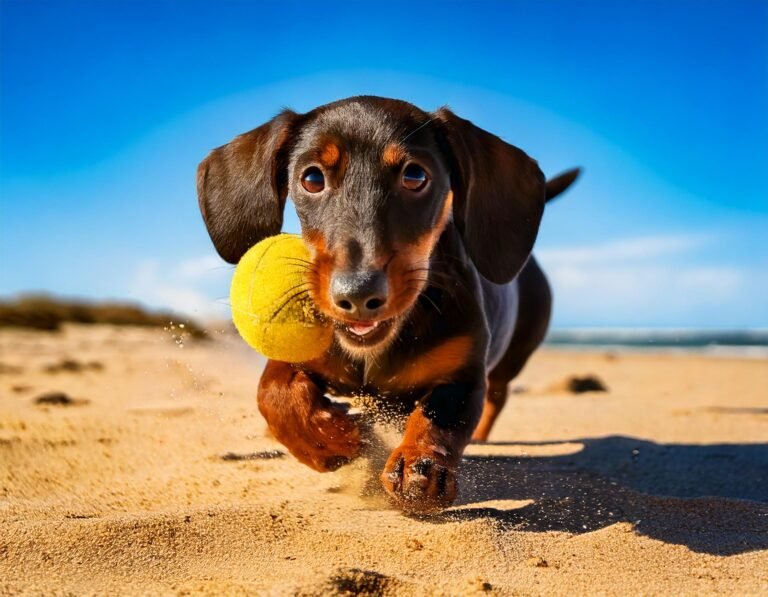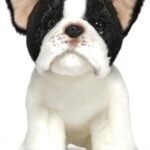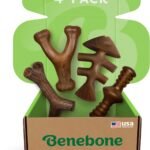


Dachshund
The Spirited "Badger Dog" with a Distinctive Silhouette
Introduction
The Dachshund, affectionately known as the “wiener dog” or “sausage dog,” is a breed that captivates with its unique appearance and spirited personality. Originating in Germany, these dogs were specifically bred for hunting badgers, a trait reflected in their name, which translates to “badger dog.” Their elongated bodies and short legs are not just distinctive but were purposefully developed to aid in burrowing and tracking prey. Today, Dachshunds continue to charm dog enthusiasts worldwide with their bold demeanor and loyal companionship.
History and Background of the Breed
The Dachshund’s lineage dates back to 17th century Germany, where breeders aimed to create a dog capable of scenting, chasing, and flushing out badgers and other burrowing animals. Their development began in 17th century Germany, where breeders aimed to create a dog capable of scenting, chasing, and flushing out badgers and other burrowing animals. Over time, the breed’s versatility allowed it to hunt various prey, including rabbits and foxes, solidifying its reputation as a tenacious and courageous hunter.
Size and Physical Characteristics
Dachshunds are a distinctive and beloved dog breed, known for their unique physical traits. They come in two main sizes: standard and miniature. Standard Dachshunds typically weigh between 16 to 32 pounds, while miniature Dachshunds weigh up to 11 pounds. Despite their small size, both varieties possess a sturdy and muscular build.
| Trait | Male | Female |
|---|---|---|
| Weight | 16–32 lbs (Standard), up to 11 lbs (Miniature) | 16–32 lbs (Standard), up to 11 lbs (Miniature) |
| Height | 8–9 inches (Standard), 5–6 inches (Miniature) | 8–9 inches (Standard), 5–6 inches (Miniature) |
| Characteristic | Description |
|---|---|
| Coat Length | Smooth (short-haired), Long-haired, Wire-haired |
| Apartment Friendly | Yes |
| Energy Level | Medium |
| Tendency to Drool | Low |
| Tendency to Bark | High |
| Tendency to Dig | High |
| Tendency to Chew | Medium |
| Human Attention Need | High |

Unique Physical Traits:
- Long, muscular body with short, stubby legs.
- Paddle-shaped front paws, ideal for digging.
- Loose skin to prevent tearing while tunneling.
- Long snout with a keen sense of smell.
- Floppy ears that help prevent dirt from entering the ear canal.
- Deep chest to accommodate a large lung capacity for stamina.
Dachshunds possess a long, low-slung body atop short, sturdy legs, giving them a unique and recognizable silhouette. Their elongated snout and expressive eyes exude intelligence and curiosity. The breed’s coat comes in three varieties—smooth, long-haired, and wire-haired—each adding to their distinctive appearance. Their paddle-shaped front paws and deep chest are testaments to their hunting lineage, designed for digging and endurance.
Temperament and Personality
Dachshunds are renowned for their bold and vivacious personalities. Despite their small stature, they exhibit a fearless nature, often displaying behaviors that suggest they are unaware of their size. This courage stems from their hunting heritage, where they were bred to confront badgers and other burrowing animals. Their independent spirit can sometimes translate into stubbornness, making training a potential challenge for first-time dog owners.
Affectionate and loyal, Dachshunds form strong bonds with their families. They thrive on human companionship and often seek attention, sometimes leading to behaviors associated with being “needy.” This desire for closeness makes them excellent companions, but it also means they may experience separation anxiety if left alone for extended periods.
While generally friendly, Dachshunds can be wary of strangers, showcasing a vigilant and protective demeanor. Their alertness, combined with a tendency to bark, makes them effective watchdogs. However, this proclivity for barking requires mindful training to prevent it from becoming excessive.
Key Personality Traits:
- Boldness: Fearless and confident, often unaware of their small size.
- Affectionate: Deeply loyal and loving towards their families.
- Independent: Possess a strong-willed nature, sometimes leading to stubbornness.
- Alertness: Vigilant and protective, making them good watchdogs.
- Playfulness: Energetic and enjoy engaging in various activities.
Understanding the Dachshund’s temperament is crucial for potential owners. Their spirited and independent nature requires consistent training and socialization from an early age. With proper guidance, they become loving and entertaining companions, bringing joy and laughter to any household.
Coat and Grooming
Dachshunds come in three distinct coat types: smooth, long-haired, and wire-haired, each with specific grooming needs. Regular grooming not only maintains their appearance but also promotes overall health.
Grooming Essentials:
- Smooth-Coated Dachshunds: Require minimal grooming. Weekly brushing with a soft-bristled brush helps remove loose hairs and keeps the coat shiny.
- Long-Haired Dachshunds: Need more frequent brushing, at least several times a week, to prevent tangles and matting. A slicker brush or comb is ideal for maintaining their silky fur.
- Wire-Haired Dachshunds: Benefit from regular brushing and periodic hand-stripping to remove dead hairs and maintain coat texture.
Regardless of coat type, all Dachshunds should have their nails trimmed regularly to prevent overgrowth, which can cause discomfort. Ear cleaning is also essential, especially due to their floppy ears, which can trap dirt and lead to infections. Regular dental care, including brushing their teeth, helps prevent periodontal disease.
Establishing a consistent grooming routine from a young age ensures that Dachshunds remain comfortable during grooming sessions. It also provides an opportunity to check for any skin issues or abnormalities, ensuring they stay healthy and look their best.
Indoor & Outdoor Living Considerations
Dachshunds are adaptable dogs that can thrive in various living environments, including apartments and houses. However, certain considerations are essential to ensure their well-being.
Living Environment Tips:
- Indoor Safety: Due to their elongated spine, it’s crucial to prevent them from jumping off furniture, which can lead to back injuries. Providing pet-friendly ramps or stairs can help them access higher areas safely.
- Temperature Sensitivity: Dachshunds can be sensitive to extreme temperatures. In colder climates, they may require sweaters during walks, while in hotter weather, it’s important to provide ample shade and hydration.
- Secure Outdoor Spaces: Their hunting instincts may lead them to chase small animals or dig. Ensuring that outdoor areas are securely fenced will prevent escapes and protect them from potential hazards.
- Supervised Play: Always supervise outdoor activities to prevent them from overexerting themselves, especially in extreme weather conditions.
By addressing these considerations, owners can create a safe and comfortable environment that caters to the Dachshund’s unique needs, allowing them to lead a happy and healthy life.
Exercise Requirements

Despite their small size, Dachshunds are energetic dogs that require regular exercise to maintain their physical and mental health. Engaging them in daily activities helps prevent obesity and reduces the risk of back problems.
Exercise Guidelines:
- Daily Walks: Aim for at least one or two short walks each day to keep them active and stimulated.
- Interactive Play: Engage in games like fetch or tug-of-war to satisfy their playful nature.
- Mental Stimulation: Provide puzzle toys or training sessions to challenge their intelligence and prevent boredom.
- Avoid High Impact Activities: Due to their long backs, activities that involve jumping or strenuous climbing should be minimized to prevent spinal injuries.
Regular exercise not only keeps Dachshunds physically fit but also curbs behavioral issues stemming from pent-up energy. Tailoring activities to their capabilities ensures they remain healthy and content companions.
Favorite Activities and Toys
Dachshunds are energetic and intelligent dogs that thrive on engaging activities and interactive play. Providing them with appropriate toys not only satisfies their natural instincts but also keeps them mentally stimulated and physically active.
Preferred Activities:
- Scent Tracking: Leveraging their keen sense of smell, Dachshunds enjoy games that involve tracking scents or finding hidden treats.
- Digging: Given their burrowing heritage, they often find pleasure in digging, so providing a designated digging area or toy can be beneficial.
- Fetch: Their playful nature makes games like fetch a favorite, allowing them to expend energy and bond with their owners.
- Puzzle Solving: Interactive puzzle toys challenge their minds and keep them occupied, preventing boredom-related behaviors.
Providing a variety of toys that cater to their natural behaviors ensures that Dachshunds remain happy, healthy, and well-stimulated. Regular rotation of toys can also keep their interest piqued and prevent monotony.
Here are some highly-rated toys on Amazon that cater to these activities:
Dog Chew Toys for Aggressive Chewers
- Keep it Healthy: puppy teething toys, these natural rubber products fully protect them at this time, as biting can cause dental problems. The bristles on the corn are neatly aligned. Dog toothpaste can be squeezed into the grooves of the dog toothbrush stick. It effectively cleans teeth and controls the growth of tartar and plaque as your dog chews on tough dog toys!

French Bulldog Plush
- MEET OLIVER THE FRENCH BULLDOG: With this 13-inch stuffed dog stature, fluffy coat, and cuddly demeanor, he’s the epitome of cute and adorable. Perfect for babies and kids, Oliver is a charming companion for endless snuggles and playtime joy.

Benebone Small 4-Pack Dog Chew Toys for Aggressive Chewers
- DURABLE, LONG-LASTING –Benebones are tougher than real bones and last for weeks. Super-chewer? Bring it on.
- REAL FLAVOR – We use only 100% REAL FLAVOR like bacon, fish and even wood. Trust us, dogs can smell a fake from a mile away.
- EASY TO PICK UP AND CHEW – Benebones are uniquely designed for a paw-friendly grip so your pup can quickly grab them and get a good chew going. Think about it: dogs don’t have thumbs

Breed-Specific Training Considerations
Training a Dachshund requires patience, consistency, and an understanding of their unique characteristics. Their independent and sometimes stubborn nature can pose challenges, but with the right approach, they can be well-trained companions.
Training Tips:
- Start Early: Begin training during puppyhood to establish good behaviors and prevent the development of undesirable habits.
- Positive Reinforcement: Use treats, praise, and affection to reward desired behaviors, making training sessions enjoyable and effective.
- Short Sessions: Keep training sessions brief and engaging to accommodate their short attention spans and maintain enthusiasm.
- Consistency is Key: Maintain consistent commands and routines to help them understand expectations and reduce confusion.
- Socialization: Expose them to various environments, people, and other animals early on to foster a well-rounded temperament.
Understanding that Dachshunds were bred for independent hunting can help tailor training methods that work with their natural instincts rather than against them. Patience and persistence will yield a well-behaved and happy companion.
Diet and Nutritional Considerations
Proper nutrition is vital for maintaining a Dachshund’s health, supporting their energy levels, and preventing obesity—a common concern in the breed due to their elongated spine.
Dietary Guidelines:
- Balanced Diet: Provide high-quality dog food that meets their nutritional needs, including proteins, fats, carbohydrates, vitamins, and minerals.
- Portion Control: Monitor food intake carefully to prevent overeating, as excess weight can lead to back problems and other health issues.
- Regular Feeding Schedule: Establish consistent feeding times to regulate digestion and metabolism.
- Limited Treats: While useful for training, treats should be given sparingly to avoid unnecessary calorie intake.
- Fresh Water: Ensure access to clean, fresh water at all times to keep them hydrated.
Consulting with a veterinarian can provide personalized dietary recommendations based on your Dachshund’s age, weight, activity level, and health status, ensuring they receive optimal nutrition throughout their life.
Health and Lifespan
Dachshunds are generally a robust breed with a lifespan ranging from 12 to 16 years. However, their unique body structure predisposes them to certain health issues that owners should be vigilant about. Regular veterinary check-ups and a proactive approach to health care can significantly enhance their quality of life.
5 Common Health Concerns
Intervertebral Disc Disease (IVDD): Due to their elongated spine and short rib cage, Dachshunds are prone to IVDD, a condition where the intervertebral discs degenerate, leading to pain, nerve damage, or even paralysis.
Patellar Luxation: This occurs when the kneecap dislocates from its normal position, causing lameness or an abnormal gait. Regular monitoring and maintaining a healthy weight can help manage this condition.
Hip Dysplasia: An abnormal formation of the hip socket can lead to arthritis and mobility issues. Early detection through veterinary screening is crucial for management.
Obesity: Dachshunds have a tendency to gain weight, which can exacerbate spinal problems and lead to other health issues like diabetes. A balanced diet and regular exercise are essential.
Eye Disorders: They are susceptible to various eye conditions, including progressive retinal atrophy and cataracts, which can impair vision. Regular eye examinations are recommended.
Being aware of these common health concerns allows Dachshund owners to take preventive measures and seek timely veterinary care, ensuring their pets lead healthy and fulfilling lives.
Tips for Successful Owners
 To ensure a fulfilling and healthy relationship with your Dachshund, consider the following tips:
To ensure a fulfilling and healthy relationship with your Dachshund, consider the following tips:
Protect Their Back: Prevent activities that strain their spine, such as jumping from heights or climbing stairs. Using ramps and providing supportive bedding can help.
Maintain a Healthy Weight: Monitor their diet and provide regular exercise to prevent obesity, reducing the risk of related health issues.
Early Socialization: Introduce them to various environments, people, and other animals early on to foster a well-adjusted and sociable demeanor.
Consistent Training: Utilize positive reinforcement techniques to address their independent nature, ensuring they respond well to commands.
Regular Veterinary Check-ups: Schedule routine health screenings to detect and address potential health issues promptly.
Implementing these tips can help Dachshund owners provide a nurturing environment, promoting the well-being and happiness of their canine companions.
Fun Facts
Here are some intriguing tidbits about Dachshunds that highlight their unique charm:
Historical Hunters: Dachshunds were originally bred in Germany for hunting badgers, with their name literally translating to “badger dog.”
Varied Coats and Sizes: They come in three coat types—smooth, long-haired, and wire-haired—and two sizes: standard and miniature, offering a variety of combinations.
Courageous Nature: Despite their small size, Dachshunds are known for their fearless and bold temperament, often taking on animals much larger than themselves.
These intriguing facts highlight the rich history and distinctive characteristics that make Dachshunds a beloved breed worldwide.

Mastering the First Impression: Your intriguing post title goes here
Engaging Introductions: Capturing Your Audience’s Interest The initial impression your blog post makes is crucial, and that’s where your introduction

The Art of Drawing Readers In: Your attractive post title goes here
Engaging Introductions: Capturing Your Audience’s Interest The initial impression your blog post makes is crucial, and that’s where your introduction

Crafting Captivating Headlines: Your awesome post title goes here
Engaging Introductions: Capturing Your Audience’s Interest The initial impression your blog post makes is crucial, and that’s where your introduction